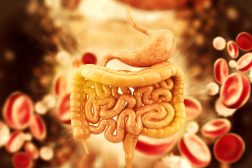Table of Contents
Definition
noun
plural: isomaltuloses
A disaccharide comprised of a glucose monomer and a fructose monomer joined by α(1→6) glycosidic bond
Details
Overview
Carbohydrates are one of the major classes of biomolecules. They are classified into monosaccharides, disaccharides, oligosaccharides, and polysaccharides. The simplest form of carbohydrates is a monosaccharide. Combining two monosaccharides by a glycosidic linkage forms a disaccharide. Isomaltulose, for instance, is a disaccharide made up of a molecule of glucose and a molecule of fructose joined by α-(1→6) bond.
Properties of isomaltulose
Isomaltulose is a disaccharide with a chemical formula of C12H22O11. It has a molar mass of 342.30 g·mol−1. Commercially, it is available as a white, crystalline powder. It has low hygroscopicity, meaning it has very low moisture absorption. Its melting point is 123-128 °C.
Isomaltulose vs. Sucrose
Isomaltulose is an isomer of sucrose (commonly known as table sugar). Isomaltulose and sucrose have the same chemical formula. Both of them are disaccharides comprised of the monosaccharides: fructose and glucose components. Isomaltulose resembles the taste and physical properties of sucrose but isomaltulose is half as sweet. Thus, isomaltulose provides the same amount of energy as sucrose does (i.e. 4 kcal/g). One of the differences between isomaltulose and sucrose is the glycosidic linkage between the monosaccharide components. In sucrose, the glycosidic bond is α-(1→2) whereas in isomaltulose, the linkage is α(1→6). This means that in sucrose the α-(1,2)-β bond forms between Carbon(C)-1 of glucose and C-2 of fructose. Conversely, the glycosidic bond in isomaltulose forms between C-1 of glucose and C-6 of fructose. This makes isomaltulose as a reducing sugar, unlike sucrose that is non-reducing. The fructose in isomaltulose is in a ring form that may open to expose its carbonyl group as in ketones and aldehydes.
Isomaltulose vs. Isomaltose
Isomaltulose and isomaltose are both disaccharide carbohydrates. Isomaltulose, though, is a disaccharide derived from sucrose. Isomaltose is a disaccharide derived from maltose. Isomaltulose and isomaltose have a similar chemical bonding in a way that a glycosidic bond connects C-1 and C-6 of the two monosaccharide constituents. In isomaltose, however, the two monosaccharides are two glucose units whereas in isomaltulose are one glucose and one fructose.
Biological activities
Isomaltulose is formed through the joining of glucose and fructose units through a glycosidic linkage by a condensation reaction. It occurs naturally and produced biosynthetically, especially by plants (e.g. sugarcane and sugar beet). It is also present in honey. It has been extracted and processed for use in the food industry where it is used as a sweetener and an alternative to sucrose. It may also be produced artificially through the enzyme sucrose isomerase from the bacterium Protaminobacter rubrum. The enzyme is used to convert sucrose from sugar beet into isomaltulose. 1
In omnivores and herbivores, isomaltulose serves as a source of energy. It can provide about the same kilocalories per gram as sucrose.1 In humans, it can be fully digested, although rather slowly, through the aid of the intestinal enzyme isomaltase. The enzyme cleaves the glycosidic bond. Consequently, glucose and fructose components are released and readily absorbed by the small intestine. The monosaccharides are next released into the bloodstream, and finally, taken up by the cells of various tissues to be metabolized.
Biological importance/functions
Isomaltulose is a nutritive carbohydrate. It serves as a source of energy. In humans, it is digested, absorbed and fully metabolized. In fact, it may serve as an essential alternative to dietary sucrose. It is half as sweet as sucrose and does not promote tooth decay. The bacteria in the mouth do not metabolize isomaltulose as much as they do with sucrose. It also has a low glycemic index (i.e. 32-37) and low insulinemic response. Thus, it is more suitable than sucrose for diabetic individuals. 1 It has also been suggested to lower the rate of fat storage. Apart from that, fat oxidation is also higher with isomaltulose than with the other dietary carbohydrates. Thus, isomaltulose is vital in the reduction of body fat and blood glucose management. It is also considered as tooth-friendly since it does not promote dental carries. The bacteria in the mouth and on teeth are responsible for dental plaques, tooth decay, and demineralization of teeth as they ferment carbohydrates, such as sucrose. Isomaltulose is hardly used by oral bacteria for fermentation and as such is tooth-friendly.
Isomalt is a disaccharide polyol from sucrose. It can be produced when isomaltulose is hydrogenated. Isomalt has been used in candies and other sweets labeled as sugar-free. When consumed, the isomalt is fermented in the colon into short-chain fatty acids.
Metabolic disorders
Congenital Sucrase-Isomaltase deficiency is a rare metabolic disorder characterized by the inability of the individual to digest certain sugars due to a deficiency of sucrase-isomaltase. Without this enzyme, isomaltose, sucrose, and isomaltulose are unabsorbed and thereby act as osmotic laxatives. The common symptoms include diarrhea, vomiting, flatulence, and abdominal distention upon ingestion of such sugars. Diagnosis is often done by hydrogen breath test or by a biopsy from the small intestine for a disaccharide assay. Genetic testing may also be done. The condition is associated with mutations in the SI gene. This gene codes for a functional enzyme sucrase-isomaltase. The mutation of this gene might have resulted in the impairment of the enzyme’s structure, function, or production. The condition is inherited in an autosomal recessive pattern.2 Management of sucrase-isomaltasse deficiency entails a modification of the diet by alleviating the consumption of starch or sucrose. Apart from sucrase-isomaltase deficient, those who have hereditary fructose intolerance should also avoid isomaltulose-laden foods. 1
Supplementary
IUPAC
- 6-O-α-D-Glucopyranosyl-D-fructose
Chemical formula
Synonym(s)
- palatinose
Derived term
Further reading
See also
- carbohydrate
- disaccharide
- sucrose
- glucose
- fructose
Reference
- Isomaltulose Calories, Foods, Benefits, Dangers. (2017, January 6). Retrieved from ://www.nutrientsreview.com/carbs/disaccharides-isomaltulose.html Link
- Genetics Home Reference. (2002, January 1). Congenital sucrase-isomaltase deficiency. Retrieved from ://ghr.nlm.nih.gov/condition/congenital-sucrase-isomaltase-deficiency#inheritance Link
© Biology Online. Content provided and moderated by Biology Online Editors







